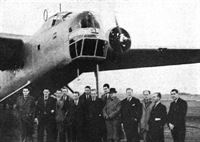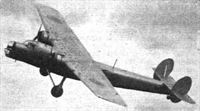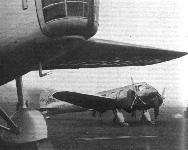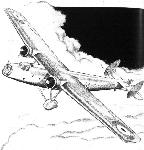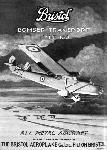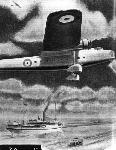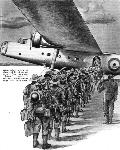
Описание
Страна : Великобритания
Год : 1935
Бомбардировщик/транспортный самолет с экипажем из трех человек
Bombay / Type 130
Самолет двойного назначения (транспортный и бомбардировщик), предназначенный в первую очередь для эксплуатации в колониях. Представлял собой двухмоторный цельнометаллический моноплан с двухкилевым оперением и неубирающимся шасси. Его создали в КБ фирмы "Бристоль эйрплейн" под руководством Ф. Барнуэлла. Опытный образец этого самолета под названием "тип 130" впервые поднялся в воздух 23 июня 1935 г. Серийное производство "Бомбея" осуществлялось с марта 1939 г. на заводе "Шорт энд Гарланд" в Белфасте. Всего изготовили 51 экз.
Экипаж - 3 - 4 чел., 24 пассажира или груз до 1000 кг. Моторы "Пегасус" XXI. Вооружение 2x7,69, бомбы до 910 кг.
"Бомбей" состоял на вооружении только в Великобритании, с сентября 1939 г.
В строевые части эти машины впервые прибыли в октябре 1939 г., когда ими оснастили одну из эскадрилий в Египте. В мае 1940 г. "бомбеи" осуществляли перевозки для Британского экспедиционного корпуса во Франции. С июня того же года их вынуждены были использовать как ночные бомбардировщики. В сентябре они осуществляли регулярные налеты на Бенгази в Ливии. В качестве бомбардировщиков в Северной Африке "бомбеи" летали до сентября 1941 г.
В апреле 1941 г. самолеты этого типа высадили диверсионную группу у Абруццо в Италии, взорвавшую там виадук. В том же месяце "бомбеи" начали вывоз из Греции эвакуируемых оттуда английских солдат и местных беженцев. Эта работа осуществлялась до мая, после чего эти машины привлекли к переброске подкреплений в Ирак в связи с мятежом Рашида Али. В том же 1941 г. "бомбеи" доставляли грузы осажденному гарнизону Тобрука.
В 1942 - 1943 гг. эти самолеты вели рутинную транспортную работу в Северной Африке. Часть машин использовалась как санитарные. Интересный эпизод был связан с дозаправкой с "бомбеев" в тылу противника, в безлюдной пустыне, эскадрильи торпедоносцев "Альбакор", атаковавших затем итальянские суда в районе, считавшемся недосягаемым для союзной авиации. В июне - августе 1943 г. "бомбеи" вывозили раненых с Сицилии. Это были их последние боевые вылеты. В Африке их списали в основном к июню 1943 г., в метрополии - к октябрю. Последние "бомбеи" летали до августа 1944 г.
"Бомбей" I||
Размах:||29,28 м
Длина:||20,76 м
Моторы, количество х мощность:||2x1010 л.с.
Взлетная масса, максимальная:||9100 кг
Максимальная скорость:||306 км/ч
Практический потолок:||7620 м
Дальность:||3560 км
Описание:
- Bombay / Type 130
- Bristol Type 130 Bombay
- Flight, June 1935
NEW and EXPERIMENTAL TYPES at HENDON - Flight, August 1939
OUR NEWEST BOMBER TRANSPORT - Flight, November 1939
Britain's Military Aircraft
Фотографии
-
Мировая Авиация 75
Регистрационный номер: L5857 [2] Этот Type 130A Bombay Mk l в 1940-1941 годах состоял на вооружении базировавшейся в Египте 216-й эскадрильи RAF. На самолетах Type 130A использовалось хвостовое оперение новой конструкции.
-
Aeroplane Monthly 1974-10 / Bristol Bombay /Press Debut/
Регистрационный номер: K3583 [15] Опытный образец самолета "Бомбей" в полете, Филтон (Англия), 1935 г.
THE “BRISTOL” BOMBAY, in production for the R.A.F.,is an all-metal bomber-transport troop-carrier accommodating 24 fully-armed troops and equipment in addition to its crew. Fitted with "Bristol” Pegasus engines. -
Jane's All the World Aircraft 1938 / 03 - All the world's aeroplanes
Регистрационный номер: K3583 [15] The Bristol "Bombay" Bomber-Transport Monoplane (two Bristol "Pegasus" engines).
Adopted by the R.A.F. as the standard type of bomber transport, the Bristol Bombay has medium supercharged Pegasus engines. Despite the fixed undercarriage and the demands of the specification, the performance is excellent. -
Aeroplane Monthly 1974-10 / Bristol Bombay /Press Debut/
Регистрационный номер: K3583 [15] -
Aeroplane Monthly 1974-10 / Bristol Bombay /Press Debut/
Регистрационный номер: K3583 [15] -
Flight 1935-07 / Flight
Регистрационный номер: K3583 [15] Metal skin construction is used in the Bristol Bomber Transport (two Bristol "Pegasus" engines).
-
Flight 1937-09 / Flight
Регистрационный номер: K3583 [15] TROOPER-BOMBER: The Bristol Bombay (Type 130) bomber-transport which recently conveyed British Staff Officers to the German manoeuvres. The Bombay is being built in quantity by Short and Harland. With two Bristol Pegasus Xs (960 h.p. max.) the performance is a revelation.
This view of the prototype Bombay shows well the wide-track undercarriage and excellent view for the forward gunner. -
Flight 1936-10 / Flight
Регистрационный номер: K3583 [15] The Bristol Bombay bomber transport (two Bristol "Pegasus") is being made in the Short and Harland factory.
-
Flight 1936-10 / Flight
Регистрационный номер: K3583 [15] THE CANARY TEST: Most people know the one about the early pioneers who turned a canary loose between their wings before taking off and concluded, if it escaped, that the rigger had omitted a few wires. Things really have changed when it is considered that a big Service transport machine can be built with such clean lines as those of the Bristol 130, Bomber Transport seen here through the inter-plane obstruction of a not-quite-so-modern type.
Air-to-air photograph of K3583, the prototype Bristol Type 130 Bombay. The revised tail-gunner’s position, note a cupola, is seen in the view. The Bombay has also been fitted with three-bladed Fairey-Reed metal propellers. -
Aeroplane Monthly 1989-12 / A.Lumsden, T.Heffernan - Probe Probare
Регистрационный номер: K3583 [15] Air-to-air photograph of K3583, the prototype Bristol Type 130 Bombay.
-
Flight 1935-12 / Flight
Регистрационный номер: K3583 [15] The graceful Bristol 130 is another bomber transport and employs two moderately supercharged Pegasus radials.
-
Aeroplane Monthly 1989-12 / A.Lumsden, T.Heffernan - Probe Probare
Регистрационный номер: K3583 [15] The prototype Bombay numbered 9 for the 1936 RAF Display, held at Hendon in June. Below, a production Bombay with the interior laid out in the ambulance configuration for evacuating casualties from the battlefields.
-
Flight 1936-06 / Flight
Регистрационный номер: K3583 [15] The Bristol 130 bomber-transport has been adopted by the R.A.F. with two Pegasus X engines.
-
Aeroplane Monthly 1989-12 / A.Lumsden, T.Heffernan - Probe Probare
Регистрационный номер: K3583 [15] The prototype Bristol Type 130 Bombay pictured at RAF Martlesham Heath. Wooden two-bladed propellers are fitted to the 750 h.p. Bristol Pegasus III engines. Originally the tail-gunner's position was an open cockpit - a cupola was fitted to production aircraft.
-
Flight 1936-01 / Flight Advertisements
Регистрационный номер: K3583 [15] Type 130 Bristol Transport Bomber
-
Flight 1935-06 / Flight
The Bristol Troop Carrier, unlike most modern machines, is a high-wing monoplane. The engines are Bristol "Pegasus" of 700 h.p. each.
-
Aeroplane Monthly 1989-12 / A.Lumsden, T.Heffernan - Probe Probare
Регистрационный номер: L5808 [5] L5808, the first production Bombay, built at Belfast by Short Brothers and Harland & Wolff. It was first flown at Belfast in March 1939.
-
Flight 1939-08 / Flight
Регистрационный номер: L5808 [5] This view gives an excellent idea of the size and appearance of the production type Bristol Bombay as built by the Short and Harland concern at Belfast.
-
Flight 1939-03 / Flight
Регистрационный номер: L5808 [5] THE PRODUCTION TYPE BOMBAY: An exclusive view of the first Bristol Bombay bomber-transport built by Short and Harland at Belfast. It will be noted that the nose has been revised and that the Pegasus engines now drive Rotol airscrews
-
Flight 1939-08 / Flight
An admiring crowd is seen surrounding the Bombay.
-
Flight 1939-04 / Flight
THE MEN AND THE JOB: A group snapped at the Belfast Works of Short and Harland Ltd., after a test flight of the first production Bombay bomber transport. Fifth from the right is Mr. J. H. Lower (manager) and the fourth from the right is Mr. H. L. Piper, of Short Brothers, who has been carrying out the test flying.
-
Flight 1939-08 / Flight
The nose of the production-type Bombay differs considerably from that of the prototype. This view shows the new bomb-aimers' position and the installation of the Bristol Pegasus XXII engines which drive Rotol airscrews.
-
Flight 1939-05 / Flight
Регистрационный номер: L5808 [5] Our new standard bomber transport aircraft is the Bristol Bombay, seen in its production form. The Bombay is fitted with two Bristol Pegasus engines giving over 1,000 h.p. each for take-off and makes use of Rotol constant-speed airscrews.
-
Air-Britain Aeromilitaria 1984-02
Регистрационный номер: L5841 Maryland BJ421 passes through Takoradi en route for the Middle East, S January 1941. In the background is Bombay L5841 SH-Y of No.216 Squadron
Другие самолёты на фотографии: Martin Maryland / Type 167 - США - 1939
-
Flight 1939-08 / Flight
TROOP TRANSPORT TRIAL: Several bomber transports were recently used to carry troops from Bembridge, I.O.W., to Yatesbury. A contingent is seen deplaning from a Bombay.
-
Flight 1940-06 / Flight Advertisements
Регистрационный номер: L5816 [2] -
Моделист-Конструктор Военно-транспортные самолеты Второй мировой войны
"Бомбей" I из 216-й эскадрильи в Северной Африке, аэродром Эль-Ханка, начало 1942 г. Под фюзеляжем машины смонтированы бомбодержатели
-
Моделист-Конструктор Военно-транспортные самолеты Второй мировой войны
Регистрационный номер: L5812 Пятый серийный "Бомбей", 1939 г.
-
Flight 1939-11 / Flight
The Bristol Bombay bomber transport which is built at the Short and Harland works.
-
Flight 1940-03 / Flight
The Bristol Bombay, although powerfully armed and capable of working as a bomber, was designed primarily to accommodate troops and to transport bulky loads.
-
Flight 1939-03 / Flight
One of the first views of the production-type Bristol Bombay as standardised by the R.A.F. for bomber-transport duties. It is built in the Short and Harland factory at Belfast.
-
Flight 1940-06 / Flight Advertisements
Регистрационный номер: L5816 [2] Each Bristol "Bombay" aeroplane - Britain's largest troop carrier - can accommodate 24 troops with full equipment.
-
Aeroplane Monthly 1989-12 / A.Lumsden, T.Heffernan - Probe Probare
Регистрационный номер: L5857 [2] Bristol Bombay L5857 of 216 Squadron was eventually destroyed in an air raid at Kufra in September 1942.
-
Flight 1939-08 / Flight
Showing how a spare engine is loaded into the capacious fuselage of the Bombay when the machine is used as a freighter.
-
Flight 1935-11 / Flight
MEDIUM BOMBER AND BOMBER TRANSPORT: The Bristol 142 (two Mercury VI S engines), although a fairly large machine, is dwarfed in this view by the Bristol 130 (two Pegasus III M engines) in the foreground.
Другие самолёты на фотографии: Bristol Type 142 Britain First / Type 143 - Великобритания - 1935
-
Flight 1935-07 / Flight
The gun turret in the nose of the Bristol Bomber Transport.
-
Flight 1936-07 / Flight
His Majesty at the controls of the Bristol 130 bomber-transport monoplane at Martlesham.
-
Flight 1935-07 / Flight
The Armstrong-Whitworth Bomber Transport (two Siddeley "Tiger VI") has a transparent gun turret at each end of its fuselage. This picture shows the rear turret.
-
Flight 1939-08 / Flight
The business-like pilot’s cockpit of the Bombay.
-
Aeroplane Monthly 1989-12 / A.Lumsden, T.Heffernan - Probe Probare
A production Bombay with the interior laid out in the ambulance configuration for evacuating casualties from the battlefields.
-
Flight 1939-08 / Flight
From left to right these interior views of the Bombay show the stretchers installed when the machine is employed on ambulance duties; the special bearers which permit the transport of spare engines; and the auxiliary fuel tanks which permit a range of 2,500 miles.
-
Air Enthusiast 1994-09 / A.Wood - Airline at War
Khartoum airfield August 21, 1941 showing the after-effects of a storm. Bombay ‘P’ of 117 Squadron lies wrecked.
-
Aeroplane Monthly 1989-12 / A.Lumsden, T.Heffernan - Probe Probare
Регистрационный номер: L5808 [5] L5808, the first production Bombay, pictured following its take-off accident at Martlesham Heath on August 23,1939.
-
Flight 1938-07 / Flight Advertisements
Регистрационный номер: K3583 [15] -
Flight 1935-07 / Flight
An aileron "tab" on the Bristol bomber transport.
-
Мировая Авиация 75
Bristol Bombay
- Фотографии






















